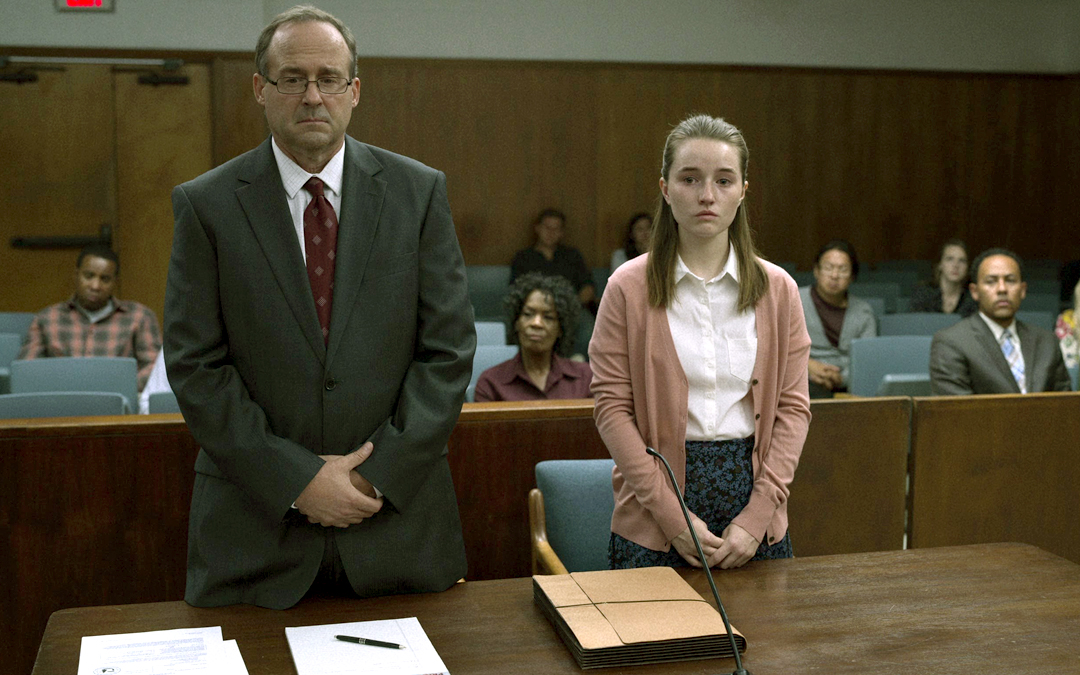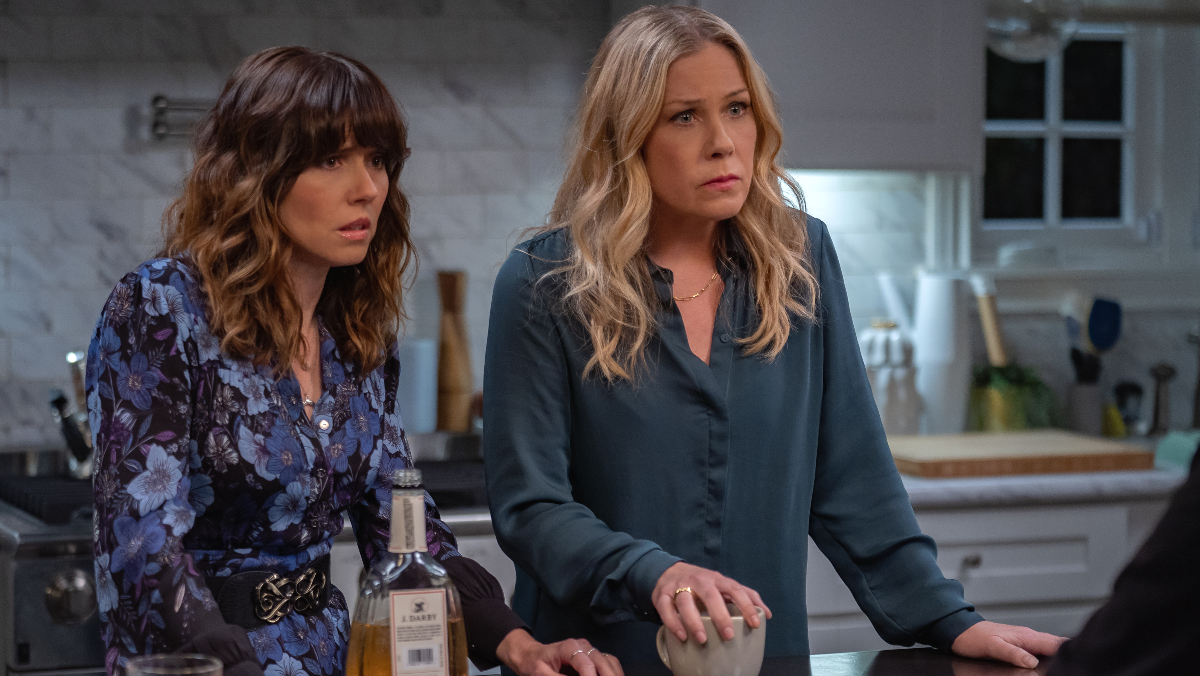All The Write Moves: 'Dead to Me'
May 13, 2019
While stories about female friendship are no longer the unicorns of Hollywood storytelling, they are still so uncommon that it’s an accomplishment whenever one makes it through the system. Kudos, then, to Netflix, which has numerous such stories within its enormous catalog, from Orange is the New Black to Grace and Frankie to a promising new offering titled Dead to Me. Starring TV veterans Christina Applegate and Linda Cardellini, the series, created by Liz Feldman, mines dark comedy from the unlikely source of catastrophic loss, because in the pilot episode, the characters played by Applegate and Cardellini meet in a group-therapy session for persons experiencing grief.
Jen (Applegate) is there because three months ago, her husband was killed by a hit-and-run driver. Judy (Cardellini) says she’s there because her fiancé died of a heart attack two months ago. To discuss how this show works, it’s necessary to spoil one of the big reveals from the pilot, so if you haven’t yet seen the first episode, read no further. Otherwise, press on—because in many ways, Dead to Me exemplifies how to craft an effective contemporary pilot. Like so many of the best shows on television right now, Dead to Me is neither purely comedic nor purely dramatic, instead following characters to the idiosyncratic places their emotions take them, genre limitations be damned.
All the Rage
The first scene sets up Jen well, because she responds to a familiar ritual—a neighbor delivering a tray of food to a grieving widow—with hostility instead of hospitality. To be clear, she’s not so much rude as she is clipped, giving the sense that she’s been through this ritual one time too many, and that she’s lost the ability to fabricate appreciation for platitudes. The neighbor hands Jen a tray of Mexican lasagna, and Jen responds by asking the neighbor to imagine that her own husband has been killed. In a word, awkward.
Throughout the pilot, Feldman delineates Jen’s coping mechanisms, nearly all of which involve anger. She drives in her car, banging her head to death metal music played at a punishing volume. She lashes out at everyone except her real-estate clients, and one can’t help but infer that she’d be thrilled to lash out at them, too. Once Judy breaks through Jen’s armor by making a series of kind overtures, Jen continues to reveal aspects of her fury, finally acknowledging that she knows how unpleasant her behavior must appear to an outside observer. “Thank you for not being repulsed by my version of grief,” she says to Judy.
That line clicks on a number of levels. Firstly, it speaks to one of the eternal mysteries of friendship in general, and female friendship specifically—true companions are the people who let us show our real selves without fear of judgment or abandonment. Secondly, the line articulates Jen’s dramatic need—she must travel through a dark tunnel before coming out the other end as a person who has recovered from grief. Thirdly, the line defines the bond that forms between Jen and Judy—for whatever reason, Judy needs so badly to connect with another person that none of Jen’s endeavors to push her away are successful. By the end of the pilot, we learn the disturbing truth behind Judy’s seemingly selfless ability to tolerate Jen’s extremes.
Takeaway: The way characters navigate hardship is profoundly revealing.
Alone Together
A great deal of screen time in the Dead to Me pilot is consumed by scenes of Judy and Jen keeping each other company during bouts of insomnia, but for many of these scenes, they’re not in the same physical space. Instead, before Jen fully embraces Judy’s companionship, they pass time with late-night phone calls, chatting while they eat from matching boxes of Entenmann’s chocolate-chip cookies and watching the same broadcasts of Facts of Life reruns. On their face, these scenes might appear to be very simple, since phone conversations are standard elements of Hollywood’s cinematic language.
In the context of this particular show, however, these phone scenes serve a more important function. Before Jen and Judy reach the necessary comfort level to occupy each other’s worlds—as in their physical spaces and social circles—they reach a preliminary comfort level by occupying each other’s psychic spaces. The women learn to maneuver around insecurities and sensitivities and triggers, thereby achieving a mutual understanding that because they wish to support each other, they can get catty or gossipy or silly—whatever it takes to generate the kind of intimacy that makes people feel heard and seen.
When writing dramatic scenes, it’s easy to forget that putting characters together in the same physical setting provides an inherent crutch. Sometimes action or time limitations shape the conversation, as when characters speak while hiking or having a meal at a restaurant. Sometimes sexual tension informs the conversation. And so on. By keeping Jen and Judy physically separate during the getting-to-know-you passage of the pilot’s storyline, Feldman helps us, the viewers, believe that these women are friends before they actually spend time together outside of therapy.
Takeaway: Dramatizing how characters bond is about more than just depicting shared experiences.
You Don’t Know Me
As noted earlier, it’s tricky to talk about the Dead to Me pilot without addressing one of the big reveals, so here’s your last warning—incoming spoiler! About three-quarters of the way through the pilot, Jen discovers that Judy lied about her reason for joining the therapy session. Judy’s boyfriend didn’t die. Instead, they broke up, and Judy reacted to the event as if it was a death. Discovering this lie causes Jen to relapse into rage, but the growth she has experienced over the course of the episode—in no small part because of Judy’s companionship—allows Jen to move past the betrayal. She lets Judy explain the reasons for the lie, accepts the explanation, and even advances their friendship to a new level by inviting Judy to live in Jen’s unused guesthouse.
Those who follow trends in pilot writing know what’s coming next—the reveal of Judy’s big secret is a fakeout, because Feldman has set the stage for the unveiling of an even bigger secret, which won’t be divulged here. Suffice to say that, like everything else in Dead to Me, this cycle of revelations functions on both narrative and emotional levels. On a narrative level, the dual secrets provide tension and tonal variety. On an emotional level, the dual secrets create a dynamic that’s worth exploring in future episodes. If this friendship can survive a lie with a relatively small blast radius, can it survive another lie that has a blast radius the size of a nuclear bomb?
Dead to Me ticks plenty of boxes, but in terms of contemporary pilot writing, this last element is arguably the most important. Likeable characters and sly jokes are reason enough to watch one episode of just about anything. What keeps us coming back for the next episode, and the one after that, is the need to answer the fundamental question underlying all dramatic storytelling: What happens next?
Takeaway: Modern pilots nearly always introduce dangerous secrets with profound emotional implications.
Written by: Peter Hanson
Peter Hanson is a Los Angeles-based writer, filmmaker and teacher. He directed the screenwriting documentary Tales from the Script, and he teaches at Pepperdine University and UCLA Extension. He provides script consulting at www.GrandRiverFilms.com.- Topics:
- Discussing TV & Film




